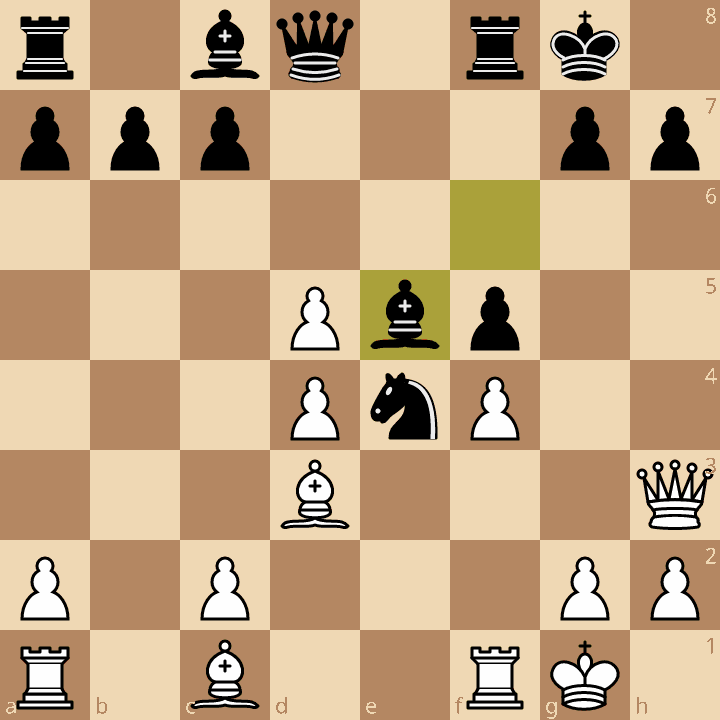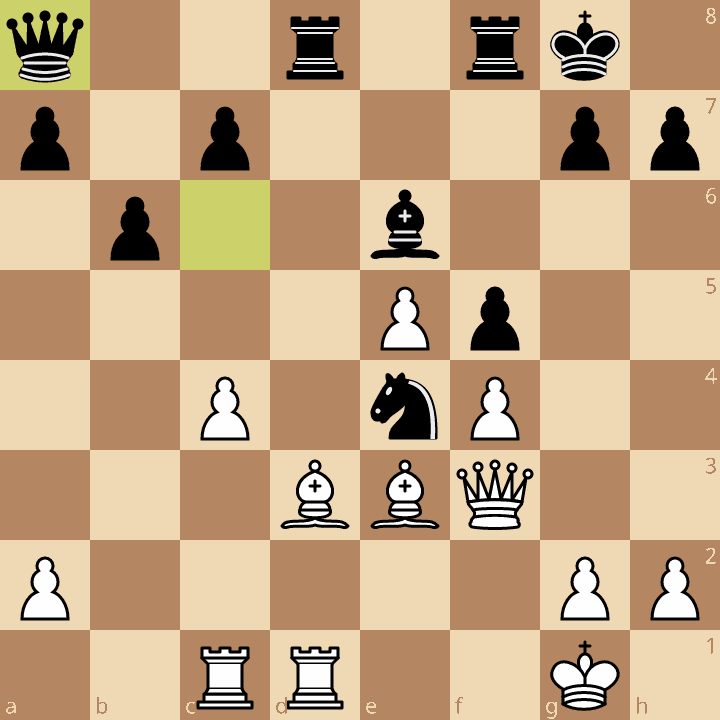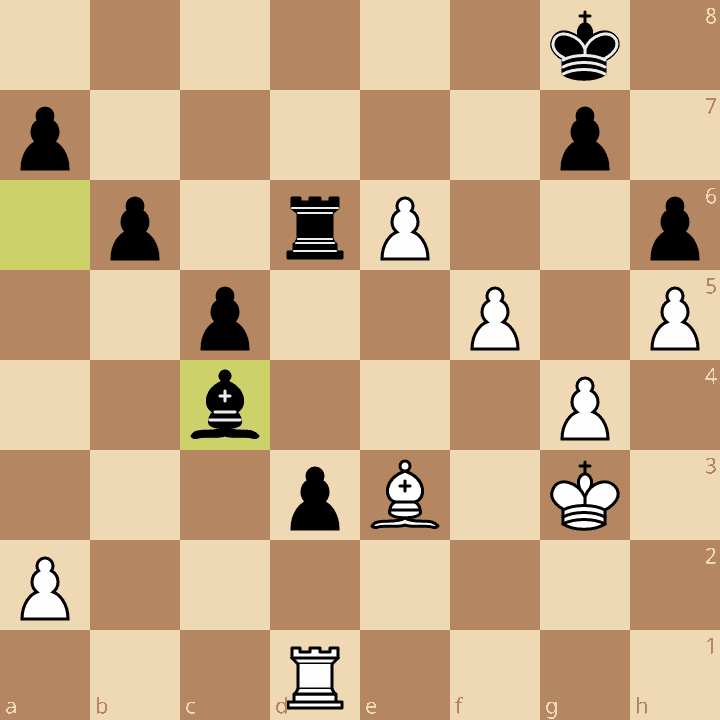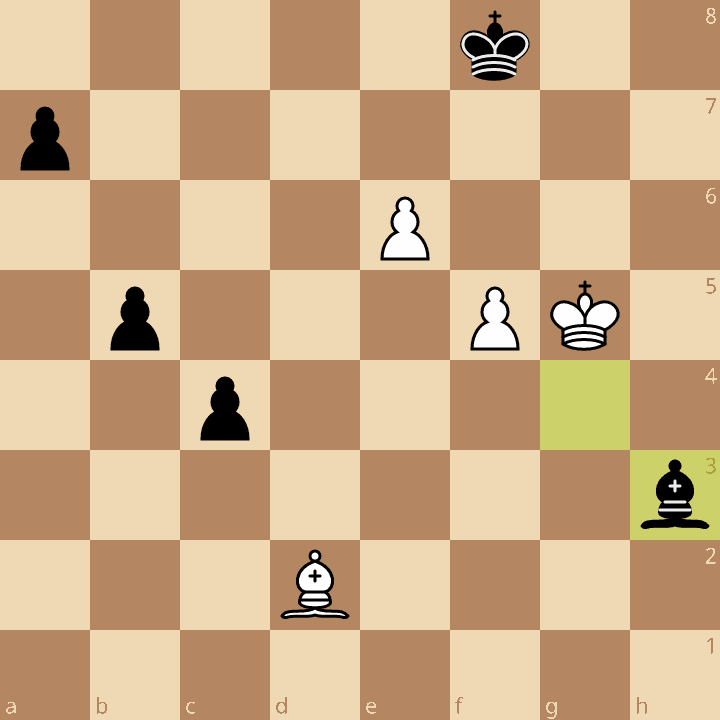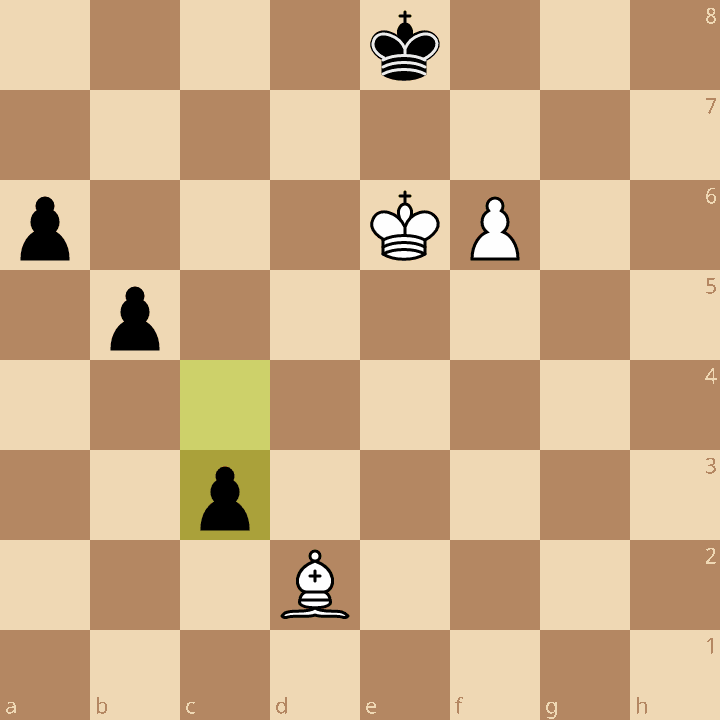For the final round of the Sacramento Chess Club Team Championship, I was expecting a pairing against an 1800+-rated player who goes into the Caro-Kann, so for week before this game, that’s what I spent a little bit of time studying. However, when the time came, the team captain, who is also third board, decided to play instead. I’ve played against Stewart Katz before OTB and online, and so I’m a bit familiar with his repertoire, and expected we would be playing a Russian game.
Time Control: 60 minutes with 15 second increment per move.
White: Me (1658 USCF)
Black: Stewart Katz (1842 USCF)
The Opening
1.e4 e5 2.Nf3 Nf6
The aforementioned Russian Game — or Petrov’s (or Petroff’s) Defense. In my opinion this move is just as good as 2…Nc6, but can result in boring games that resemble the French Exchange Variation, depending on how players react to it. The symmetrical pawn structure is part and parcel with the Exchange French, but perhaps Black is a bit more actively posted in the center. So it’s a good game either way. Like Nf6 in many other 1.e4 openings, it’s a very forcing move, because it threatens White’s center immediately.
3.d4
This is called the Steinitz Attack. I’ve played this line online and over the board many times.
Unlike in the last OTB game I had this opening, my opponent chooses the better line.
3…Nxe4
Making good on the threat to capture the central pawn. The idea behind this line for White is to rapidly develop and put pressure on this knight, and if possible force Black to trade it off, winning time. In the past six months, I’ve done well against this line with the White pieces in online blitz (+9/-6/=1), but this success is relatively recent. It’s very easy for me to try to pressure Black’s position more than the position warrants, and that leads me into troubled waters. Only recently have I figured out how to play against Black here without dubious sacrifices in the middlegame.
4.Bd3
Beginning the scheme of development with tempo. Because this move comes with a concrete threat, there is no need to fret about recapturing the pawn with 4.dxe5 — Black doesn’t have time to protect it.
4…d5
Solidifying the knight’s position on active e4 square, but in the end we’ll force it to move one way or another.
5.Nxe5
This knight does better here than a pawn. To start, the open e-file benefits White more, because of the lead in development, and the knight is more active here. Since the position is extremely symmetrical, so long as White plays actively, Black cannot make threats without some sort of consequence.
5...Be7
At this point I’m already out of book. I have multiple courses recommending 5.Nxe5 lines for White, but none of the ones I own suggest anything against this Be7 move — it’s not considered at all, even though I find it to be solid and a decent default move against a lot of lines in lots of different openings. Now I have to improvise, but due to the passive nature of this move, I feel pretty comfortable. This move has been played over a hundred times in master play according to the Lichess database. White scores very high: 70.5%.
6.O-O O-O
Now for an interesting choice. Typical in lines like this would be moves like this, and in analogous lines in the exchange French, are moves like c3, c4, or Nd2. But I like the idea of clearing the d3-bishop’s diagonal and putting pressure against the kingside, which means that maybe I can entice my opponent into it by offering a long-term strategic weakness in my pawn structure and accelerate my piece play.
7.Nc3!?
The overwhelming choice for masters here is indeed 7.c4, with 88% of games following that line. Nc3 is a bit less popular at 6%. However, in the lichess players database, it is chosen 27% of the time vs c4’s 53%, and it performs better than c4 at the amateur level. So it looks like I made the more practical choice. Stockfish, at least at depth 23, thinks these moves are equal. In the end it’s probably a matter of taste.
7…Nxc3
This move isn’t forced, but the other options Black has may not be nearly as pleasant:
7…Nf6 represents a clear vindication of White’s play and just gives White more time.
7…c5 comes a little too late: 8.Nxe4 dxe4 9.Bxe4 cxd4 (9…Qxd4 10.Qe2) 10.Qh5! forcing weaknesses in Black’s king position, which may not be a problem if Black had more defenders near the king.
7…Ng5 just runs into 8.f4 Ne6 9.Be3. White’s just got an active position here and all the play.
8.bxc3 Nd7
The most popular move regardless of masters or lichess players. Black is trying to relieve the pressure, much like White could have played Nd2 on move 7.
9.f4!?
A double-edged move with some fascinating statistics.
No master games with this move. Masters have played 9.Nxd7, or 9.Be3. Engine likes those moves, but also suggests 9.Rb1 or even the very positional 9.a4.
This move is played the plurality of times (at 34%, vs Qh5’s 25%) in the Lichess database. 9.Qh5 keeps equality. 9.f4 actually swings the evaluation in black’s favor, but just by a smidge. Despite the engine’s pessimism, White scores about 59% from here in player’s games above 1800 on the lichess database. So practically, it’s a good move!
I asked the #chesspunks community on X and got some interesting responses, but in general, most people thought f4 was just the way to go.
9…f5!?
Black returns the favor! However, my knight is practically cemented into the e5 square for good, whereas he has nothing as of right now to get into the e4 square yet, and it’ll take some time to accomplish that, giving me some extra moves to build my position further.
9…Nxe5 10.fxe5 is probably about as good as the text move for Black. It looks dangerous, and indeed was the position I envisioned as ideal, but I think Black has enough defensive resources to deal with White’s pressure.
9…c5! was probably the strongest. It undermines the center, frees up Black’s play on the queenside, and in general goes for counterplay rather than passive response to White’s plans.
10.Qh5!?
Just applying a bit of pressure before relocating the queen. I’m not going for cheapos here.
10…Nf6 11.Qh3
This is the best square for the queen. the queen may help support a kingside pawn push at the right moment, but it’s also out of the way of the rooks which have yet to be connected.
The Middlegame
11…Ne4
Unlike the Knight on e5, this one doesn’t seem as stable because of White’s next move, which immediately undermines its position.
12.c4! Bf6?!
Preparing to chop the knight off of e5. A really passive move. I don’t think he likes the idea of cxd5, but this allows me to play it. Probably best was 12…c6, just defending the pawn, and making sure there’s an open c-file for the queen and/or rooks, if White chooses to swap on d5. Along the same lines, 12…Be6 would prevent the worst.
12…dxc4?? is bad. 13.Bxc4+ Kh8?! (Black must sacrifice the rook to prevent checkmate) 14.Ng6#
13.cxd5 Bxe5
I’m happy to see this move. Right now the center is a bit clogged; but I think White’s bishops will rule the day here as the center can open pretty easily in some lines. In any case, this was good for me, and though consistent with the previous move, bad for Black. Stockfish so dislikes this idea it suggests sacrificing a pawn with c6 or c5 instead.
13…Qxd5?? 14.Bc4 was a nasty trap.
14.dxe5?!
A decision I spent some time on, but not best.
14.fxe5 is best. However, I did not understand why this is so strong. Analyzing with Stockfish 16, I saw a few lines. The most understandable was this: 14…Qxd5 15.Bb2! Nd2 16.Rfd1 Nc4 17.Bxc4 Qxc4 18.d5! In my notes I wrote “OK, these pawns do look strong.” I think that the support of the open f-file allows for some threatening operations surrounding the f7 square (once e6 has been played). In any case, it’s clear this is a much more active position for White and the queen is the only real player for Black’s side.
In the actual game position, practically the chances must still reside with White — the power of this passed pawn will shine in the endgame, if we ever get to one.
14…Qxd5 15.Be3
To connect the back rank and prevent checks on c5. I also looked at 15.c4?! Qd4+ 16.Be3?? but that drops a bishop, and 15.Bxe4 Qxe4 16.Qb3+ In general I think White’s strengths in this position do reside in the bishops being active and that trades are what Black needs to survive.
15…Be6 16.Rfd1
This defends the bishop on d3, and prepares c4. At this point, I think that I’ve already allowed Black equality, but nothing more. So I’m trying to generate ideas and come up with interesting plans.
16…b6
I’m not sure what the plan is for this move other than to allow the queen passage to behind the queenside pawns.
17.c4!?
Since b6, the queen cannot go to c6 with any protection, which means I can start threatening some ideas regarding either Qf3 and/or Bf3/e4.
17…Qc6
Why not Qb7? Maybe to keep pressure on c4.
18.Rac1 Rad8 19.Qf3
Now I am preparing to play g4 and push on the kingside. Because of the e4 knight’s tenuous position, g4 could come with a lot of pressure.
19…Qa8
Prophylactic, not as weak as it looks. The queen is now defended and perhaps a knight move is hanging in the air.
20.h4!?
Still preparing g4. I want to prevent or inconvenience the idea of playing g6. 20.g4 didn’t look quite as strong as Black can play …g6.
20…c5
I still don’t know what the purpose of this move was. It does gain space, and maybe prevents a later c5 by White to wreck the queenside pawns?
21.h5! h6 22.g4!?
My plan is successful! To be clear, the position here is still basically equal according to the computer. But I think that practically it’s easier for me to play this position. Black’s position is strong and solid enough that with perfect play, it should draw. Luckily for me, neither of us club players are anywhere near perfect, and I could tell that I had the psychological advantage as my opponent continued to visibly display some frustration.
22…Bc8?!
A move I noticed, but my opponent must not have, was the radical but very strong 22…Rxd3! 23.Rxd3 fxg4 24.Qg2. This is still equal, but White has no more attack. Given that the main attacker of the light squares was traded off at the cost of an exchange and a pawn, White might have some practical chances here, but it’s very hard to prove it, because the e3 bishop is so poorly placed and has no job, whereas the e6 bishop is rather effective and unhindered by most of black’s pawns.
Had my opponent seen this, this would have been a completely different game.
Because the bishop on c8 undefends the queen, I now have a new option to trade into an endgame, and the passed pawn I created on move 14 suddenly has an enterprising future. Besides this, playing something like 23.g5 would allow Bb7, which just looks annoying and not that good for White. It’s an opposite-color bishop endgame, though, which means that I have to be careful. It turns out that I did not make every consideration correctly in this endgame, but I still felt confident that White should have more chances to win than Black.
23.Bxe4! Qxe4
After 23…fxe4 24.Qg3, the pawns begin to march!
24.Qxe4 fxe4
The Endgame
25.f5!?
White could also play 25.Rxd8 Rxd8 26.f5 as an alternative.
25…Rd3 26.Rxd3 exd3
27.Rd1?!
Apparently close to drawing. It took me a while to find out why as I was analyzing and writing this post. White loses a tempo to Ba6 which could have been spent moving the king toward the kingside pawns. Should Black ever play d2, Rd1 could then be played after which point White can win the pawn on d2. The c4 pawn may fall but White’s majority will win vs black’s queenside runner on the c-file, which also has the misfortune of being the wrong color (White’s bishop covers the promotion square and cannot be opposed by Black’s light-squared bishop. Instead, 27.e6 Rd8 28.Kf2 Ba6 29.Kg3 d2 30.Rd1 Bxc4 31.Rxd2 Rxd2 32.Bxd2 was similar to what occurred in the game, but the immediate pawn push to e6 is better because this position arrives by force (or worse for Black).
27…Rd8 28.e6 Rd6?!
28…Ba6 and it’s completely equal. 29.Rc1 d2 30.Rd1 Bxc4 31.Kf2 Bxa2 32.Kf3 Bb3 33.Rxd2 Rxd2 34.Bxd2 and Black will find a way to a draw after 34…a5.
29.Kf2
The King can infiltrate via g3-f4, but my first idea was to cover the d2 square. In general, the king moves I make in this segment of the game are inadvisible.
29…Ba6
Probably Black’s only real bid for counterplay.
30.Kg3?
Switching plans. The aforementioned 30.Rc1 needed to be played. 30…d2 (30…Bb7 and now 31.Kg3 continues the winning path). 31.Rd1 Bxc4 32.a3! (32.Rxd2? should draw) and Rxd2 is coming, the queenside pawns are paralyzed, and White can begin the final march on the kingside and center.
30…Bxc4
What else? Black has sufficient counterplay and should draw, due to the inaccuracies I committed the last few moves.
31.Bf4
I couldn’t play 31.a3? because then 31…Bb3 32.Rb1 (32.Rd2 is even worse due to 32…c4!) Bc2 33.Re1 d2 34.Bxd2 Rxd2 35.e7 Rd3+ 36.Kf4 Rd4+ and the e-pawn will be stopped by Ba4, or if Ke5??, Kf7 and White is in serious danger of being mated.
31…Rd5 Kf3
Here, Black is actually maybe a bit ahead according to the engine. At this point, White is on the worse side of a draw.
31…Kf8 31.Ke3 d2?
33…Bb5 would do just fine. Black panicked, perhaps due to low time. We were both under pressure at this point.
34.Kf3?
But why? 34.Rxd2 Rxd2 35.Kxd2 Bxa2 and White will win.
34…Bxa2
Black now has three passed pawns to counter White’s far-advanced one.
34…Bd3 35.Rxd2 c4 would be tough for White to win.
35.Rxd2 Rxd2 36.Bxd2
Compared to the note at move 34, White has a worse position, though it would be hard for Black to draw this.
36…Bb1??
I guess the idea would be to prevent my king from e4, but ultimately it can’t be stopped from infiltrating. 36…a5 37.g5 hxg5 38.Kg4 is similarly bad for Black. 36…Bb3 is the most resilient and defends.
37.Kf4!?
37.Bc3 puts pressure on g7 immediately, threatening e7+ Kxe7 Bxg7.
37…b5?
The final mistake, which makes winning the game on a few minutes rather trivial.
38.Be3!
Found immediately and played as my time was getting really low. Highlighting Black’s error. My opponent cursed to himself about this, realizing that the game was now lost. Black must move the c-pawn and this allows White to dominate the passed pawns by controlling the squares in front of them.
38…c4 39.Bd2!
Sliding back cheekily. I think of this move as very Silmanny — it’s not critical, but it’s just as good. 39.Bxa7 works too, as does 39.Bc5+ Ke8 40.Bb4
39…Bd3 40.g5!
Now we are breaking through. I want to liquidate any more pawns on the light squares, and this also allows my king further into the position to while covering the pawn chain.
40…hxg5 41.Kxg5 Be2 42.h6
One less pawn for that bishop to target.
42…gxh6+ 43.Kxh6 Bg4 44.Kg5 Bh3
44…Bxf5 loses, despite the White pawn being “wrong-colored” (e.g. e8 cannot be covered by the dark squared bishop), but at the time, under the influence of time pressure, I was worried this was not the case. Obviously White wins, since the queenside pawns still cannot advance: 45.Kxf5 Ke7 46.Ke5 a6 47.Bb4+ Ke8 48.Kf6 Kd8 49.e7+ Ke8 and White will get the king to f7 as Black is now in zugzwang.
50.Bd2! a5 51.Bxa5 b4 52.Bxb4 c3 53.Bxc3 Kd7 54.Kf7 — White wins.
Back to the game:
45.Kf6 Ke8 46.Ke5
Now White can start pushing the pawns.
46…a6
46…Bxf5 would lose similarly to the note to move 44.
47.f6 Bxe6
Desperation. The promotion and mate is impossible to stop.
48.Kxe6 c3
49.f7+ Kf8
In the end I must admit that the promotion was stopped, but my opponent allows me an aesthetic mate.
49…Kd8 delays mate by a few moves:
50.Kd6! cxd2 f8=Q#, or f8=R#(!!)
50.Bxc3 b4 51.Bxb4 a5 52.Bxa5+ Kc8 53.f8=Q+ Kb7 54.Qb4 Ka6 55.Qb6#
50.Bh6#
Takeaways:
Endgame ideas are subtle, and the more time I have to play them, the more accurate I’ll be. I got lucky that my opponent didn’t capitalize on the many chances I gave him.
Sometimes the engine incorrect move is the practically correct move. I’m talking about 9.f4!?, but this applies to many lines and openings.
I’m really proud of the result of this game. As mentioned earlier, I felt like I had a certain curse that prevented me from winning with the White pieces in the team championships, and this was the first time I finished with a positive score. As a result of this win, I was able to keep my rating above 1650, which was a nice touch, though in the end I dropped 7 or so points. Psychologically this was an important game for me to win. In the end, my team did not win the championship, but it was still a worthwhile experience and it was nice to end the tournament with one of the best games I’ve played yet.
Full game in a GIF.








